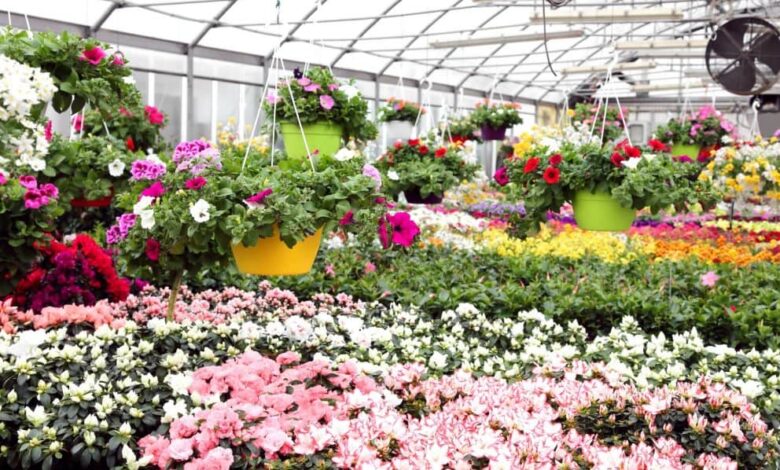Control Your Grow: Different Types of Growing Environments

Greenhouses can create the perfect controlled growing environment. After all, they allow plants to utilize the sun for the energy required for photosynthesis, to metabolize nutrients into biomass. Nature provides this for free.
By controlling the environment within the greenhouse, we are able to offer crops a simulated environment coexisting with the nature outside. Therefore, many crops are viable inside greenhouses that could not be otherwise grown in that particular climate zone. Enclosed indoor gardens offer the same benefits.
Spare rooms are perfect for growers to seal up and grow in. Virtually any plant can be cultivated indoors in a simulated environment much different from the geographic location of the building in which the room is located.
As most buildings are kept at a comfortable room temperature, one of the rooms or areas of the building can be easily converted into an indoor garden. By using today’s available technologies and equipment, virtually any crop can be grown in a controlled environment.
Greenhouses
Depending on the amount of technology in the greenhouse, there can be great variance in production quality. This is usually due to the greenhouse effect and low insulation ratings which greatly test the building’s ability to maintain an artificial environment.
For this reason, some consider greenhouses to be more like outdoor agriculture, but given the correct level of sophistication, greenhouses can outperform many indoor gardens.
Although most greenhouses use the method of exchanging air from the outside world and moving it throughout the greenhouse, there are other technologies, such as positive pressure or enclosed greenhouses, in which air is not simply moved through the greenhouse, but rather captured and recaptured while being manipulated and controlled using various equipment and technologies.
Most greenhouses use the former. As the air is pulled through the greenhouse, heat is removed in the process. As heat is removed, so is CO2 and humidity. In drier climates, greenhouses can easily be cooled by pulling air across saturated sponge-like pads on one end and with exhaust fans on the other.
In winter months, less air exchange is required for heat removal, so less fresh CO2 is being provided to the stomata. Some greenhouse cultivators will supplement CO2 with a regulator, controller and injection system.
Greenhouses take advantage of the daily photons available and the spectrum of the sun. High-tech greenhouses also take advantage of manipulating the sun’s cycles. By installing a blackout system, greenhouses can easily control the photoperiod, essentially controlling the season.
Depending on the area’s available sunlight in winter months, some greenhouses may require supplemental lighting. Lighting technology continues to evolve and companies invest vast amounts into research and development as they attempt to duplicate the sun’s spectrum and photosynthetically active radiation (PAR) for optimal photosynthesis. For this reason, greenhouses have much inherent potential in crop yield and quality.
The greenhouse effect can heat up the inside considerably higher than outside temperatures. This can be advantageous in the winter and challenging in the summer. By utilizing today’s latest technology and equipment, greenhouse growers are able to maximize yields and profits by minimizing costs in the long term.
Indoor gardens are sometimes known for higher quality than greenhouses mainly because of increased temperatures created by the greenhouse effect. By controlling these important environmental parameters and using indoor gardening techniques, greenhouse growers are also able to produce high-quality crops.
Non-Sealed Indoor Grow Rooms
Much like a typical greenhouse, in a non-sealed or open room, air is being exchanged between the outside world and the controlled environment. The room is influenced by outside conditions so tools and equipment are used to enhance the environment.
Air conditioning is often needed to remove the immense amount of heat put off by the lights and other equipment. Exhaust fans and other ventilation equipment such as ducting and filters are used to direct heat outside during summer and can be reconfigured to take advantage of the heat from the lights during winter.
Indoor grow tent kits attempt to mimic nature. This means simulating the sun inside an enclosed indoor space. Fortunately, today’s agricultural lighting technologies allow for us to create indoor grow rooms with up to 1,500 uMoles per second, per square meter at a distance of one foot over the canopy (full noon sun is around 2,000 uMoles per square meter).
Today’s lighting technology delivers the appropriate daily light integral (DLI), or amount of daily light required, for virtually any plant to survive and thrive in an indoor garden.
Lighting technology continues to evolve exponentially and therefore, serious indoor cultivators should upgrade their lighting systems periodically to take advantage of improvements in efficiency and current technology’s best attempt to duplicate the sun’s spectrum.
In an open-air exchange room, can-style exhaust fans and other cooling and ventilation equipment can be triggered by thermostat controllers capable of determining day or night and programming unique settings for each.
For example, it is likely that less air exchange will be required at night due to decreased transpiration, and thus, decreased need for fresh CO2. Night temps will also be lower so fans won’t be needed to remove heat as often. A night program on a thermostat controller might be set to turn on exhaust fans at 10 degrees cooler than a day time setting.
Another consideration while ventilating a non-sealed indoor room is to filter the incoming air in order to prevent dust and pests. If odor is of concern, the internal and outgoing air can be scrubbed with a cylinder shaped carbon filter. The filter would ideally be placed up high where hot air is moving by default, and the exhaust fan would be used inline with ducting, pulling air through the carbon filter and across the light reflectors, removing the heat and odors.
If an internal air scrubber is needed for additional odor control, use an additional carbon filter running with a can-style fan placed on top, which creates a loop in the room that absorbs the volatile organic compounds (VOCs), or odor-causing molecules and prevents smells from seeping out of the garden.
Finally, consider the temperature of the incoming air. In extremely cold or hot months, it may be necessary to buffer the air somewhere first, be it a closet, bathroom or laundry room, for example. Otherwise, the plants would not like the outdoor air being pulled directly across the garden during the more extreme months.
Pay attention to the maximum and minimum temperature and humidity reached between visits to the garden and make adjustments accordingly.
A non-sealed indoor room moves outside air through the garden. This provides plants with the fresh CO2 they need to breathe. Controlling the temperature and humidity of the air inside the garden can be done using these methods and produces a top-notch garden.
Sealed Indoor Grow Rooms
A sealed room requires more equipment, but offers a way to completely control the environment. There are no inputs from the outside world. Everything affecting the environment happens from within. Lights produce heat which has to be controlled and cooled, except for in winter when the heat produced by lights can be used to bring up the ambient room temperature if necessary.
In most areas, air conditioning will be needed because of the extreme amount of heat produced by the grow lights and other equipment. The air conditioning is the room’s only method of obtaining fresh air, so it is important to monitor CO2 levels. The air is not being exchanged in the room so the plants are not receiving much fresh CO2.
Because the room is sealed and fresh CO2 is not being brought in, it must be supplemented using a CO2 injection system or a CO2 generator. Either system would require the use of a regulator and a room controller to measure the amount of CO2 in the environment and turn the unit off when desired levels have been reached.
This is extremely important for safety reasons due to the inherent risk of using CO2 in a controlled environment. Since CO2 is heavier than air, it can accumulate to unsafe levels, especially in low areas such as basements, and as we cannot smell it, this effect can be dangerous. Therefore, levels must be monitored closely.
Because the room is sealed and there is no ventilation, the humidity will increase rapidly, especially when plants are transpiring and growing quickly. Therefore, a dehumidifier will need to be used to remove excess moisture. In a sealed room, there is no ventilation to remove it otherwise.
For added insurance, gardeners can add an extra layer of control and provide ventilation set on a hygrometer controller that would trigger the emergency ventilation fan if humidity levels rise too far above 60 per cent, which is where mold and mildew can begin to occur.
In rare instances, such as in extra dry climates or when starting in an empty indoor grow room that is not already full of heavily transpiring plants, a humidifier may be necessary to bring the humidity up to at least 35 per cent.
One way to keep the room sealed and still remove heat produced by the lights is to choose lighting fixtures with ducting attachments and sealed glass. They can use inline ducting with a can-style fan, pulling air through the light reflectors.
The air can be brought in from outside of the room and passed directly over the lights and removed directly from the room, without mixing with or obtaining any of the air within the room. The room would remain sealed, and the ‘in’ and ‘out’ holes would be cut just large enough to let the ducting pass through.
Yet another way to remove heat from the growroom is to remove the items causing heat. It is obviously not feasible to remove the lights, but what about the ballasts? After all, they are designed to be a heat sink, so why not install them outside of the growroom?
This can be done by installing a small hole to run ballast cords through. Other equipment that produces heat such as stand-alone air conditioners are designed with ducting to help direct and remove the excess heat caused by the unit.
Although completely sealed rooms provide for more parameters to control, understanding these methods and tools empowers growers to create a highly sophisticated, controlled environment capable of maximizing yields and producing top-quality harvests.
It’s Time to Get Growing
While designing a controlled environment in which to grow, gardeners should consider the above options thoroughly before choosing whether or not to grow in a sealed or non-sealed room or even a greenhouse.
One configuration is not necessarily better than another and it should be a subjective decision based on personal preferences and capabilities. If limitations arise, consider another option.
Don’t be afraid to start small. Take enjoyment in letting your controlled environment grow alongside your garden and have fun with it. Happy gardening!
For more valuable information visit the website





